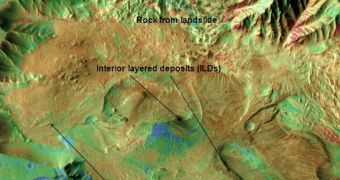A class of mysterious geological features on the surface of the Red Planet, which have been defying explanation for years, has finally revealed its nature to researchers at the NASA Johnson Space Center (JSC) and the Planetary Science Institute (PSI).
The joint team proposed a new hypothesis, which explains how Interior Layered Deposits (ILD), large sedimentary deposits in the Valles Marineris came to be. Their explanation involves a cold and dry climate, ant massive, dust-rich glaciers.
Valles Marineris is a massive canyon system on Mars. Geologists now believe that it was once occupied by very large glaciers, at least several billion years ago. At that time, the neighboring world still had water on its surface.
These ice accumulations contained important amounts of dust. As the climate dried up, and the water began to slowly retreat underground, the dust remained behind, leading to the formation of deposits.
“Icy weathering might be a major part of the geologic story on Mars. The planet has been in a cold, frozen state for a long time,” PSI research scientist Joseph Michalski explains.
“In the distant past, it was also cold, but volcanoes were much more active, periodically pumping huge amounts of sulfur into the atmosphere, which could have ultimately ended up trapped within ice alongside plentiful dust,” the expert goes on to say, quoted by Astrobiology Magazine.
Details of how this happened were published in the March 26 issue of the esteemed journal Geology, in a paper entitled “Atmospheric origin of Martian interior layered deposits: Links to climate change and the global sulfur cycle.”
Researchers now believe that an important part of the current Martian geology can be explained by the numerous cycles of dust deposition, ice precipitation and sublimation, and sulfur outgassing that occurred on the planet during its distant past.
“Even so, the hypotheses are not without certain complications and uncertainties. It is our hope that more scientists will be begin to test these ideas,” Michalski goes on to say.
Despite decades of arduous investigations, Mars has yet to reveal most of its secrets, especially in terms of geology and landscape features. But the Mars Science Laboratory (MSL) rover is on its way over, and will contribute to deepening our understanding of the Red Planet starting this August.

 14 DAY TRIAL //
14 DAY TRIAL //